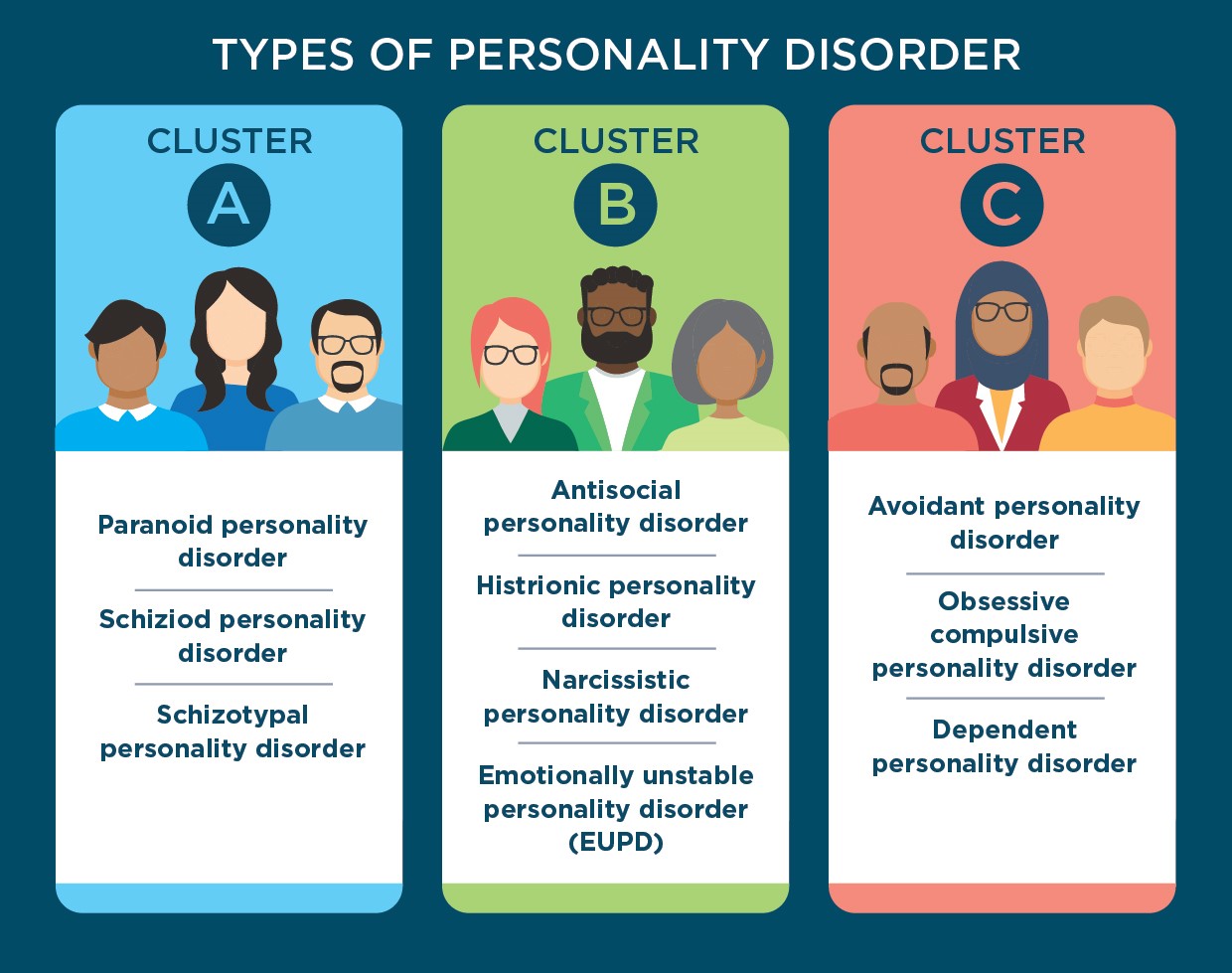
The DSM-5, or the Diagnostic and Statistical Manual of Mental Disorders, Fifth Edition, is a manual published by the American Psychiatric Association. It provides diagnostic criteria and descriptions for mental disorders, including personality disorders. The term “personality” is used to describe a person’s characteristic patterns of thinking, feeling, and behaving that persist over time and across different situations. A personality disorder is diagnosed when the aforementioned patterns deviate significantly from cultural norms, thereby causing distress or impairment in functioning. Each personality disorder, such as borderline personality disorder, is defined by specific criteria that distinguish it from other disorders and from normal variations in personality.
Cluster A vs. Cluster B
The DSM-5 distinguishes between two distinct groupings of personality disorders: Cluster B and Cluster A.
Cluster B encompasses borderline, narcissistic, histrionic, and antisocial personality disorders. Individuals with Cluster B disorders often exhibit dramatic, emotional, or erratic behavior. They may have intense, unstable relationships, struggle with impulsivity, and have difficulty regulating their emotions. These disorders typically involve behaviors that can disrupt social and interpersonal functioning.
Cluster A (Odd or Eccentric Disorders) includes paranoid, schizoid, and schizotypal personality disorders. Individuals with Cluster A disorders tend to display odd or eccentric behavior, have difficulties in social relationships, and may have unusual beliefs or perceptions. They often have limited emotional expression and may appear detached or suspicious.
Individuals diagnosed with Cluster B personality disorders exhibit erratic and dramatic behaviors, whereas those diagnosed with Cluster A personality disorders display eccentric and odd behaviors, along with difficulties in social functioning.
Cluster A vs. Cluster C
The DSM-5 delineates three clusters of personality disorders, of which Cluster A and Cluster C are the first two. The following is a description of the differences between the two.
The first cluster, designated as Cluster A, encompasses disorders characterized by odd or eccentric behaviors. This cluster encompasses the following personality disorders: paranoid, schizoid, and schizotypal. Those afflicted with these disorders often exhibit peculiar or eccentric behavior, experience difficulties in social relationships, and may espouse unconventional beliefs or perceptions. These individuals tend to exhibit a lack of emotional expressiveness, often appearing detached or suspicious.
The third cluster, designated as “Anxious or Fearful Disorders,” is as follows: This cluster encompasses avoidant, dependent, and obsessive-compulsive personality disorders. Individuals with Cluster C disorders typically experience high levels of anxiety and fear. Individuals with Cluster C disorders may exhibit avoidance of social interactions, excessive reliance on others for support, or a preoccupation with orderliness and control. The primary distinction between these disorders lies in their distinctive patterns of behavior, emotional expression, and social interactions. Cluster A disorders are characterized by unconventional or eccentric behavior and difficulties in social interaction. Cluster C disorders are marked by intense anxiety, fear, and difficulty coping with uncertainty or imperfection.
Cluster B vs. Cluster C
The DSM-5 distinguishes between Cluster B and Cluster C, which represent two distinct groupings of personality disorders. The following is a summary of the key differences between the two groups:
The second cluster, designated as Cluster B, encompasses disorders characterized by dramatic, emotional, or erratic behaviors. The cluster includes borderline, narcissistic, histrionic, and antisocial personality disorders. Individuals with Cluster B disorders frequently display behaviors that are dramatic, emotional, or erratic. Such individuals may exhibit intense and unstable relationships, struggle with impulsivity, and have difficulty regulating their emotions. These disorders are typically associated with behaviors that can disrupt social and interpersonal functioning.
The third cluster, Cluster C, encompasses disorders characterised by anxiety or fear. This cluster encompasses avoidant, dependent, and obsessive-compulsive personality disorders. Individuals diagnosed with a Cluster C disorder often exhibit elevated levels of anxiety, fear, or apprehension. Such individuals may avoid social interactions, exhibit a tendency to rely excessively on others for support, or display a proclivity for orderliness and control. These disorders frequently manifest as behaviors aimed at reducing anxiety or coping with perceived threats.
Cluster B disorders are distinguished by their dramatic and erratic behaviors, while Cluster C disorders are marked by anxious or fearful behaviors. Both clusters present unique challenges in terms of emotional regulation, interpersonal relationships, and overall functioning.